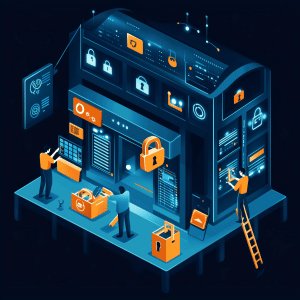Running a small business in 2025 means your company lives in two worlds: the physical storefront or office where you serve customers face-to-face, and the digital world where you manage operations, communicate with clients, and handle finances. Just as you wouldn’t leave your physical business unlocked overnight, you can’t afford to leave your digital business unprotected.
Think of internet security like the locks, alarms, and security cameras you use to protect your physical location. The threats may be invisible, but they’re just as real—and often more devastating than a traditional break-in.
The Digital Landscape Has Changed
The internet safety challenges facing small businesses in 2025 are more sophisticated than ever. Cybercriminals have professionalized their operations, treating attacks on small businesses like an assembly line. They know that small retail shops and professional service firms often lack dedicated IT staff, making them attractive targets.
Consider this: a burglar might steal a few hundred dollars from your cash register, but a cybercriminal can potentially access your bank accounts, customer data, and shut down your entire operation for days or weeks. The average cost of cybercrime for small businesses now exceeds $25,000 per incident, and that doesn’t include the immeasurable cost of lost customer trust.

Password Security: Your Digital Keys
Imagine if you used the same key for your business, your home, your car, and your safety deposit box. If someone copied that key, they’d have access to everything. That’s exactly what happens when you use the same password across multiple accounts.
Many business owners still use passwords like “password123” or their business name followed by the year. This is like leaving a note on your door saying “The key is under the mat.” Cybercriminals use automated tools that can try thousands of password combinations per second, and simple passwords fall within minutes.
The solution is to use a password manager like Bitwarden, which acts like a master locksmith for your business. It creates unique, complex passwords for every account and stores them securely behind one master password. You only need to remember that single master password—the password manager handles the rest.
For your master password, create something memorable but complex. Instead of “Greenshields2025,” try a phrase like “My coffee shop opened on Main Street in 2018!” This gives you a strong, memorable password that tells a story.
Email: The Front Door to Your Business
Email has become the primary attack vector for cybercriminals targeting small businesses. Think of your email inbox like the front door of your business—you need to be very careful about who you let in.
The most dangerous emails often look completely legitimate. Remember the example of the “boss email scam”—where you receive an email that appears to be from the business owner saying something like “I’m in a meeting and need you to quickly buy $100 in Target gift cards for a client presentation.” These emails prey on employees’ desire to be helpful and their assumption that urgent requests from the boss should be handled immediately.
Here’s your email safety checklist, like a bouncer checking IDs at your door:
Verify Before You Trust: If you receive an unusual request via email—especially involving money, gift cards, or sensitive information—pick up the phone and call the person directly. Cybercriminals are banking on you being too busy or too polite to double-check.
Look for Red Flags: Poor grammar, urgent language (“do this immediately!”), requests for gift cards or wire transfers, and emails that create artificial pressure are all warning signs. Legitimate business communications rarely demand immediate action on financial matters.
Hover Before You Click: Before clicking any link in an email, hover your mouse over it to see where it actually goes. A link that says “YourBank.com” might actually lead to “Y0urBank.com” (with a zero instead of an ‘O’).

Software Updates: Maintaining Your Digital Infrastructure
Think of software updates like routine maintenance on your building. You wouldn’t ignore a broken lock or a faulty alarm system, yet many businesses ignore software updates for months or years.
Every piece of software in your business—from Windows to your accounting program to your web browser—occasionally discovers security vulnerabilities. When software companies release updates, they’re essentially fixing broken locks that criminals have learned to pick.
Cybercriminals specifically target businesses running outdated software because they know these vulnerabilities exist and haven’t been patched. It’s like they have a list of every building in town with broken locks, and they systematically work through that list.
The solution is to enable automatic updates wherever possible and regularly check for updates on critical business software. This is like having a maintenance crew that automatically fixes security issues before they become problems.
Backup Strategy: Your Business Insurance Policy
Imagine if someone broke into your business and destroyed all your files, customer records, financial data, and inventory systems. How long would it take you to rebuild? Now imagine if this could happen with a single malicious email attachment.
Ransomware attacks have become increasingly common, and they work exactly like this scenario. Criminals encrypt all your business data and demand payment to unlock it. Even if you pay (which experts recommend against), there’s no guarantee you’ll get your data back.
The best defense is the same strategy you’d use for any valuable asset: insurance. In the digital world, that insurance is called backup.
Follow the 3-2-1 backup rule: Keep 3 copies of important data, store them on 2 different types of media, and keep 1 copy offsite. For most small businesses, this means your working files, a local backup, and a cloud backup service.
Test your backups regularly, just like you’d test smoke alarms. A backup system that doesn’t work when you need it is worse than no backup at all—it gives you false confidence.
WiFi Security: Securing Your Digital Storefront
Your business WiFi network is like the perimeter of your property. An unsecured WiFi network is equivalent to removing the walls around your business and inviting everyone to walk through your operations.
Use strong WPA3 encryption (or WPA2 if WPA3 isn’t available) with a complex password. Create a separate “guest” network for customers that doesn’t connect to your business systems. This is like having a public lobby that’s separate from your private office areas.
Regularly change your WiFi passwords, especially if employees leave or if you suspect someone unauthorized has accessed your network.
Employee Training: Your Human Firewall
Your employees are simultaneously your greatest cybersecurity asset and your biggest vulnerability. Like training staff to spot counterfeit bills or suspicious customers, you need to train them to recognize digital threats.
Conduct regular, brief training sessions covering current scams and threats. Make it clear that questioning suspicious emails or requests isn’t just okay—it’s part of their job. Create a culture where “I wasn’t sure, so I checked with you first” is praised, not criticized.
Professional Protection: When to Call in the Experts
Just as you wouldn’t try to rewire your building’s electrical system yourself, some cybersecurity tasks require professional expertise. Vulnerability scanning, security monitoring, and incident response are specialized skills that require dedicated tools and knowledge.
Professional cybersecurity services can monitor your systems 24/7, identify vulnerabilities before criminals find them, and respond immediately to threats. This is like having a security company watching your business around the clock, rather than just hoping nothing bad happens.

Looking Forward: Staying Safe in an Evolving Threat Landscape
Cybersecurity isn’t a one-time project—it’s an ongoing practice, like maintaining your physical business premises. Threats evolve constantly, new vulnerabilities are discovered regularly, and criminals develop new tactics continuously.
The key is building good habits and systems that can adapt as threats change. Focus on the fundamentals: strong passwords, regular updates, reliable backups, and employee awareness. These basics will protect you against the vast majority of threats.
Taking the Next Step
Protecting your business online doesn’t have to be overwhelming. Start with the basics—implement a password manager, enable automatic updates, and set up regular backups. Then gradually add more sophisticated protections as your comfort level and needs grow.
If you’re feeling overwhelmed by the technical aspects of cybersecurity, or if you want to ensure your business has comprehensive protection, consider partnering with a managed service provider who can handle the technical details while you focus on running your business. Sometimes the best security strategy is knowing when to call in professional help.
Remember: in 2025, cybersecurity isn’t just an IT issue—it’s a business survival issue. The investment you make in protection today could save you from devastating losses tomorrow.


Leave a Reply